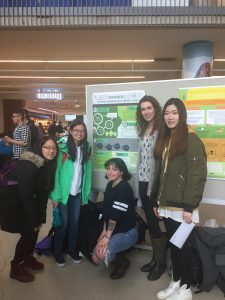Welcome to our last blog post! As the term winds down, we are working hard to tie up the loose ends of our project and work hard on our final report. We have been happy with the results and progress of our project and hope that we can continue this in completing our final report. In this blog post, we will be discussing our experience in creating and presenting our infographic.

What
Recently, we had the opportunity to present our findings in a poster presentation in the Nest at UBC. A couple of our group members created an infographic, that summarized our project, while a few others presented it to people walking through the Nest. The infographic was a great way to summarize our findings and project on a large poster size paper, and the public nature of the presentation was a good opportunity to spread our research to other students and faculty. We were able to engage our peers in our project, by presenting a little bit of our methods from our project and by answering questions.
In creating our infographic, we used the program called piktochart. This program allowed us to create a poster that was suitable and personalized to our project and findings. It was a relatively easy program to use and resulted in a very appealing end product.
Presenting our project and seeing our infographic in print was truly amazing. It felt like all of our hard work throughout the term has paid off! We were really proud of ourselves and the hard work that we had put into our project, which made it much easier to present and share our findings with others.
So What
Producing the infographic was an important part in our learning, as this is a skill that could be important for our use in the future, whether it be for another class or job. It allowed us to summarize our most important findings, in a few sentences, while also making the poster attractive and appealing, so that people would stop and learn more about our research.
In addition, a few of us were able to develop our public speaking skills in the presentation. This was a good opportunity for us to learn how to convey our findings in layperson terms and learn how to facilitate a discussion with the public around food security and food justice. From this, we were able to bring more awareness to concepts that we have learned in class, so that the public can be more mindful of the issues that surround food security and food justice.
Now What
“In professional education, it is insufficient to learn for the sake of knowledge and understanding alone; one learns in order to engage in practice.” (Shulman, 2005, p. 18) LFS 350 gave us the opportunity to learn about food justice, and allowed us to apply it in our project. Through our project, we developed a better understanding of the concept. We were also able to integrate what we have learned in other courses, in creating and scaling up the recipes.
In completing our project we created three new vegan recipes, in addition to scaling up 8 existing recipes, all of which can be used at GNH to serve the community at their Monday vegan community lunch program. In order to promote a healthier and low-cost diet, GNH can print out the recipes and share them with the community members or provide tips on how to eat healthily and cook a nutritious meal. Our meals can provide inspiration for GNH community members, to cook vegan meals or meals with lots vegetables at home.
Closing remarks
Time flies, from feeling uncertain about the project to discussing with the community partner to working on the project, we had an opportunity to learn new things and improve our skills. Making infographic and presenting it made us think of the most important findings and outcomes of our projects, what did we learned and what do we want people to know about this project. We felt accomplished after completing our infographic. Our final task would be writing our report to share our experiences.
Reference
Shulman, L. S. (2005). Pedagogies of uncertainty. Liberal Education, 91(2), 18–25. Retrieved from http://files.eric.ed.gov/fulltext/EJ697350.pdf